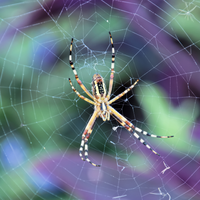social insects

Secret to Reproductive Ants’ Longevity Revealed
Patience Asanga | Sep 2, 2022 | 3 min read
Researchers say they've figured out how some reproductive ants live up to 30 years—far longer than workers.

A Single Transcription Factor Changes Ants to Queens
Abby Olena, PhD | Nov 5, 2021 | 3 min read
The transcription factor can also drive the opposite transition depending on which hormone activates it, according to a new study.

Top Spider Biologist’s Research Under Fire
Amy Schleunes | Feb 10, 2020 | 2 min read
After the initial announcements of two retractions, scientists have mobilized to interrogate the data in nearly 150 of Jonathan Pruitt’s papers.

Image of the Day: Reprogrammed Ants
Emily Makowski | Nov 13, 2019 | 2 min read
Watch soldier ants behave more like foragers after scientists change their gene expression.

Image of the Day: Corn Fed
Catherine Offord | Nov 29, 2018 | 1 min read
Bumblebee colonies grow poorly in landscapes dominated by maize, researchers find.

Infected Ants Chemically Attract Workers to Destroy Them
Jim Daley | Apr 1, 2018 | 4 min read
Social insects kill infected individuals for the benefit of the colony—and now a study has shown how they know who’s sick.

Researchers Grow “Frankenstein Ants” to Study Epigenetics
Jeffrey M. Perkel | Oct 1, 2016 | 4 min read
A molecular biologist ventures into entomology to use genetically modified ants as laboratory models of behavioral epigenetics.

Methylation’s Role in Eusocial Insect Behavior Questioned
Catherine Offord | Jan 21, 2016 | 2 min read
Researchers re-examine the evidence for DNA methylation as the cause of behavioral differences among social insects.

Slippery When Wet
Jenny Rood | Jan 14, 2015 | 2 min read
Carnivorous pitcher plants gobble more ants by turning off their traps in dry weather.

The Genetics of Society
Claire Asher and Seirian Sumner | Jan 1, 2015 | 10 min read
Researchers aim to unravel the molecular mechanisms by which a single genotype gives rise to diverse castes in eusocial organisms.

Connecting the Dots
Anna Azvolinsky | Aug 1, 2014 | 8 min read
Extending her initial studies of social wasps, Mary Jane West-Eberhard has spent her career probing the evolutionary relationship between social behavior and developmental flexibility.

Genome Digest
Abby Olena, PhD | Feb 6, 2014 | 5 min read
What researchers are learning as they sequence, map, and decode species’ genomes

Week in Review: January 13–17
Tracy Vence | Jan 17, 2014 | 3 min read
Debating the origins of placental mammals; H. pylori-human coevolution; ant, bee, and wasp queens emit similar pheromones; profiling protein expression in single cancer cells

The Shared Perfumes of Queens
Ed Yong | Jan 16, 2014 | 3 min read
Ant, bee, and wasp queens emit a similar class of pheromones that sterilize their workers, hinting at a shared ancestry for these chemicals.

From Parasites to Protectors
Dan Cossins | Sep 9, 2013 | 3 min read
Socially parasitic ants can serve as protective symbionts for their fungus-growing hosts in the face of attacks by predatory raiding species.
